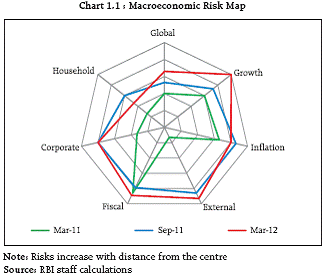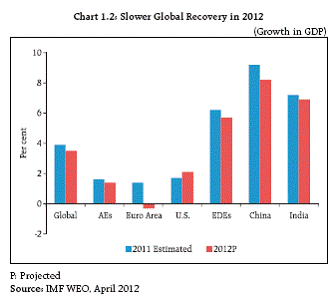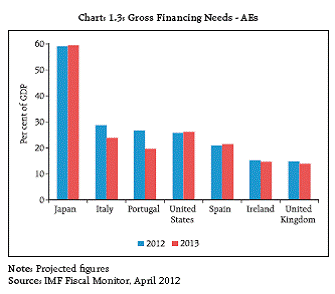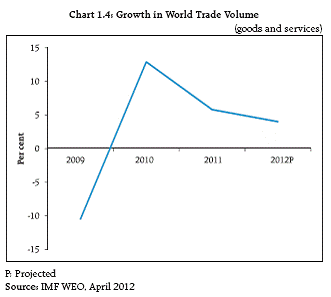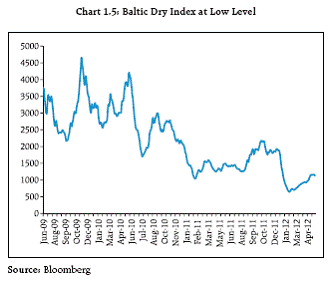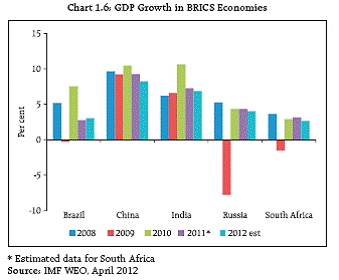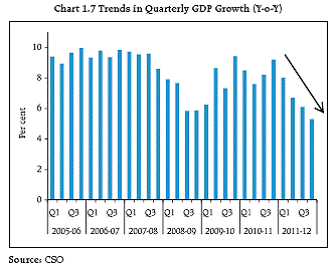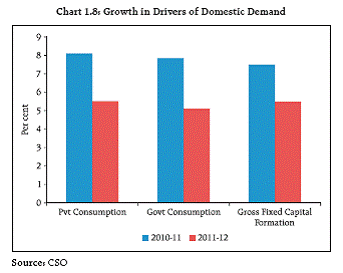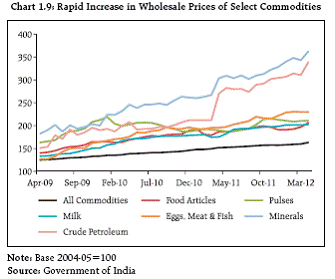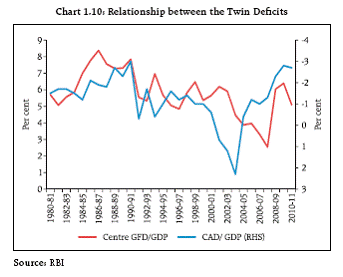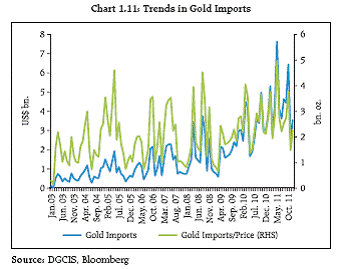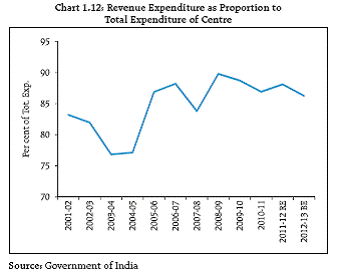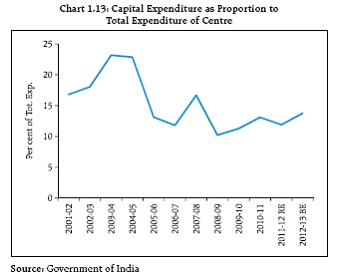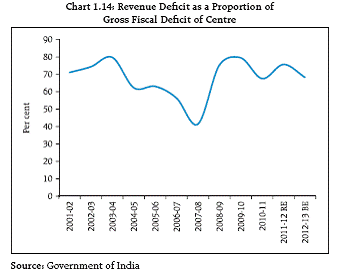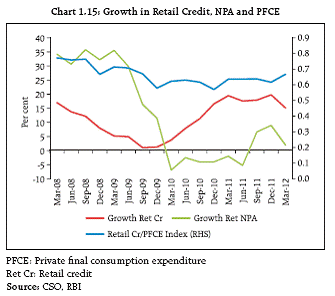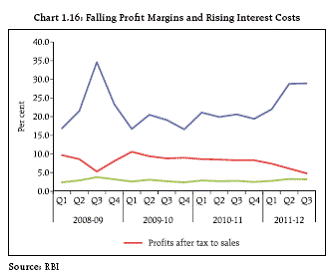Chapter I : Macroeconomic Outlook - আৰবিআই - Reserve Bank of India
Chapter I : Macroeconomic Outlook
Global and domestic outlook has worsened since the time of publication of the previous FSR. The Euro area sovereign debt problem is continuing to weigh on global recovery. Although slowing global growth has dampened commodity prices, heightened risk aversion and the resultant slowing of capital flows are likely to adversely impact emerging and developing economies (EDEs). On the domestic front, while growth has clearly decelerated, inflation risks remain. Notwithstanding the moderation in core inflation, the persistence of overall inflation, in the face of significant growth slowdown, points to serious supply bottlenecks and sticky inflation expectations. The increase in current account deficit (CAD), despite the slowdown in growth, is symptomatic of demand-supply imbalances and a pointer to the need to resolve the supply bottlenecks. A widening CAD in the face of worsening global economic and financial conditions and muted capital flows has exerted downward pressure on the rupee. Prospects for increasing capital inflows depend on both global conditions, particularly a credible resolution of the Euro area situation, and an improvement in the domestic investment climate. Thus, key risks to domestic macroeconomic environment seem to arise from global sovereign debt problem and risk aversion, domestic fiscal position, widening CAD and structural aspects of food inflation. Macroeconomic risks to financial stability higher since previous assessment 1.1 The uncertain global situation, rising risk aversion and slowing capital inflows, largely resulting from the Euro area sovereign debt problem are impacting the EDEs. They pose challenges to India’s growth and balance of payments outlook. Domestically, the widening CAD, lower levels of capital flows and increasing share of short-term debt in total debt heighten external sector risks. Fiscal slippages and slackening in growth in the recent quarters have enhanced the vulnerability to shocks. Risks from the corporate sector balance sheets have remained elevated due to relatively unfavourable domestic and external macroeconomic environment, e.g. subdued domestic consumption and investment demand, rising costs of inputs, deceleration in exports and risks from unhedged foreign currency. Risks in the household sector, however, have moderated (Chart 1.1).
The Global Economy Sluggishness in global recovery becomes more widespread… 1.2 The global economy remained on a slow recovery path during the period under review. Growth in the advanced economies (AEs) remained sluggish in last quarter of 2011 and first quarter of 2012. IMF as well as the European Commission have indicated that the Euro area will undergo a mild recession in 2012. EDEs are also expected to slow down (Chart 1.2).
… with downside risks persisting 1.3 The slowdown in the Euro Area is spreading through trade, finance and confidence channels to other AEs and to EDEs. In the short run, fiscal consolidation measures, especially in the Eurozone, could impact demand and growth adversely. The recent string of rating downgrades of Euro area sovereigns and banks could raise borrowing costs. Growth, both in the Eurozone and in other parts of the world, is also likely to be affected by deleveraging by EU-based banks1. EDEs, in particular, remain vulnerable to the spillovers of the accommodative monetary policies in AEs, especially in the Eurozone (Chapter II). Global fiscal risks have intensified 1.4 Recent developments in the Eurozone, have led to an intensification of fiscal risks globally. Debt and gross financing needs continue to be high in several AEs, even as sovereign yields are rising (Chart 1.3). There are concerns that the recession in the Eurozone may be used by countries to scale back or defer fiscal consolidation measures, especially in the current political climate. Relevant in this context is the observation by IMF in its Fiscal Monitor, April 2012, “. … Should growth slow further, countries with fiscal space should allow the automatic stabilizers to operate freely and allow the deficit to rise to avoid excess fiscal contraction, which could worsen economic conditions. But short-term caution should not be an excuse to slow or delay efforts to put public finances on a sounder footing over the medium term…”
Elevated unemployment in the U.S. and rising unemployment in the Eurozone could add to risks 1.5 Unemployment in AEs remains high and could act as a drag on recovery and fiscal consolidation. The unemployment rate in the US increased to 8.2 per cent in May 2012 from 8.1 per cent in April, the first increase in 11 months. Unemployment in the Euro area rose to 11 per cent in April 2012 - the highest rate on record. The unemployment rate is particularly acute in Spain (at nearly 24.3 per cent) and in the periphery Eurozone. Trends in global growth are mirrored in global trade volumes…. 1.6 The slowdown in global growth is reflected in sluggish trends in the volume of international trade (Charts 1.4 and 1.5). These trends are unlikely to reverse in short run given the uncertainties about the outlook for global growth.
The Domestic Economy Domestic growth decelerated on the back of global and domestic factors 1.7 Domestic GDP growth declined sharply to 6.5 per cent during 2011-12 from 8.4 per cent in the previous year, weighed by global uncertainties as well as domestic cyclical and structural factors. The trend reflected the experience of several EDEs, especially the BRICS countries (Chart 1.6).
1.8 Importantly, the quarterly growth rates have been showing a declining trend for the preceding four quarters with the fourth quarter GDP growth rate slowing to 5.3 per cent – the lowest quarterly growth rate in last 7 years (Charts 1.7).
1.9 The slowdown in real GDP was reflected in all the major sectors. Growth rate in agriculture at 2.8 per cent is due to the base effect (agriculture rate growth during 2010-11 stood at 7.0 per cent as against a trend growth of around 3.0 per cent). Slowdown in industrial activity is on account of weak demand for consumer durables, interest rate sensitivity, deceleration in external demand and subdued investment demand as well as a decline in business confidence amidst the prevailing interest rate environment. Manufacturing slowed down from 7.6 per cent in 2010-11 to 2.5 per cent in 2011-12. During the same period, growth rate in the services sector moderated from 9.2 per cent to 8.5 per cent and the moderation was observed in several segments of the sector. Subdued corporate investments and declining net exports dragged down aggregate demand… 1.10 All the major drivers of domestic demand, recorded sharp deceleration during FY12 (Chart 1.8). The sharp moderation in real GDP at market prices from 9.6 per cent in 2010-11 to 6.9 per cent in 2011-12 was reflected in all components of aggregate demand – consumption (private and government), investment and net exports. Weakness in investment, in particular, has implications for the near and medium-term growth outlook.
..while declining savings and investment rates added to concerns 1.11 Both investment and saving rates declined in 2010-11. Gross domestic savings rate declined from 33.8 per cent in 2009-10 to 32.3 per cent in 2010-11 while gross capital formation rate declined from 36.6 per cent to 35.1 per cent. Corporate pipeline investment has shrunk and new investment remains subdued, affected by the domestic and global growth outlook, higher interest rates and rising input prices. Given these trends, the outlook for domestic growth is unlikely to improve in the short term. 1.12 Headwinds from the global economy will continue to impact domestic growth in the coming quarters. Going forward into 2012-13, downside risks to growth are likely to persist, especially if the monsoons are significantly below long period average. The index of industrial production increased by just 0.1 per cent in April 2012. Though the manufacturing Purchasing Managers’ Index (PMI) for May 2012 suggested that industrial activity remains in expansionary mode, the pace of expansion seems to have slowed down significantly. Demand conditions may also improve, though constraints might be faced due to low pipeline investments. Inflationary pressures moderate but risks remain 1.13 Headline Wholesale Price Index (WPI) inflation has declined largely on account of transitory factors including a favourable base effect and seasonal decline in vegetable prices. The headline WPI inflation, which was above 9 per cent during April-November 2011, moderated to 6.9 per cent by end-March 2012, consistent with the Reserve Bank’s indicative projection of 7 per cent. The moderation was initially driven by softening of food prices and then by a decline in non-food manufactured products (core) inflation, which fell below 5 per cent for the first time in two years. However, headline inflation thereafter, inched up to 7.6 per cent in May 2012 driven mainly by food and fuel prices (Chart 1.9). Notably, the consumer price index (CPI) inflation (as measured by the new series, base year: 2010) increased sharply from 7.7 per cent in January, 2012 to 10.4 per cent in April, 2012.
1.14 Notwithstanding the recent moderation in global crude oil prices and domestic price pressures in manufactured products, upside risks to inflation remain. The likely trends in global crude oil prices, going ahead, remain uncertain. Moreover, the impact of the lagged pass-through of rupee depreciation, suppressed inflation in energy and fertilisers and possible fiscal slippage continue to pose a significant threat. While moderation in global commodity prices could aid in checking inflationary trends in the coming months, this could at least partially be offset by the depreciation of the rupee. Inflation risks are likely to remain high, given the persistence of overall inflation, even in the face of significant growth slowdown which points to serious supply bottlenecks and sticky inflation expectations. External sector risks intensified as the external sector vulnerability indicators deteriorated 1.15 The external sector position weakened in the period under review, driven by a worsening CAD, rising external debt and weakening Net International Investment Position (NIIP). 1.16 All the key external sector vulnerability indicators - the reserve cover of imports, the ratio of short-term debt to total external debt, the ratio of foreign exchange reserves to total debt, the debt service ratio and NIIP-GDP ratio - deteriorated (Table 1.1).
Prevailing global uncertainties accentuate risks to the CAD... 1.17 The trade deficit increased primarily because of the slowdown in global demand and the inelastic nature of oil imports. Pressures on the deficit were further aggravated by the fact that the non-oil imports remained high. 1.18 Given the uncertain global environment, the CAD is likely to remain elevated in the near term. Though export demand had benefitted in recent periods due to diversification of export markets to EDEs, export growth is likely to remain sluggish in the coming quarters as slowdown in AEs is increasingly affecting growth in EDEs. The widening CAD, notwithstanding slowdown in growth and depreciation of the currency, reflects the demand-supply imbalances and is a pointer to the urgent need to resolve the supply bottlenecks. Softening of global oil prices and the recent moderation in imports of gold may alleviate the pressures on the external deficit. The CAD is also susceptible to deceleration in receipts due to moderation of software exports, business services and investment income. … leading to increased risks in financing the external deficit 1.19 Risks to financing the CAD have intensified in recent months. Global developments such as deleveraging by European banks have affected capital flows, especially to emerging markets like India (Chapter II). The moderation in capital inflows has necessitated financing of the CAD by drawing down foreign exchange reserves in recent quarters. This has weakened the external sector resilience of the economy as discussed earlier. 1.20 Future capital inflows will depend on conditions in the global economy as well as the evolving domestic macroeconomic environment, including the pace of domestic policy reforms. Domestic factors including slowdown, potential downgrade by rating agencies and a depreciating exchange rate may affect capital inflows. All of these are likely to pose challenges for the financing of the CAD. Recent measures to encourage capital inflows may alleviate these risks 1.21 A host of administrative measures have been taken of late to improve inflows of external commercial borrowings (ECBs) and NRI deposits. The increase in the all-in-cost ceiling, and other relaxations in ECB guidelines could facilitate overseas borrowings by corporates. Also, greater flexibility has been given to banks in mobilising non-resident deposits by deregulating interest rates on NRE and NRO accounts in November 2011 and raising the ceiling on interest rates on FCNRB in May 2012. Exporters have been asked to convert half the foreign currency balances in the EEFC accounts to the domestic currency. FII investment in non-convertible debentures / bonds issued by Indian companies in the infrastructure sector was enhanced to USD 25 billion and limit for investment in Government securities was raised to USD 20 billion. Such measures are expected to provide a reprieve to the pressures on the external sector. Fiscal consolidation could aid the moderation of external risks... 1.22 If budget deficit is expanding and private sector savings and investment balance remains unchanged, high fiscal deficit can be financed only by expanding CAD. In the Indian context, the most visible link between the fiscal deficit and CAD is provided by oil prices. As prices for a number of petroleum products remain administered in the domestic market and are not significantly aligned to movement in international prices, a rise in international prices does not lead to demand adjustment in the domestic economy but rather results in a high import bill and higher CAD. On the other hand, underpricing of petroleum products with no moderation in domestic demand leads to rise in petroleum subsidies and hence expansion of fiscal deficit (Chart 1.10).
…As will waning gold imports 1.23 As discussed, imports have remained high given elevated global oil prices and sustained domestic demand for gold. India has traditionally been one of the largest consumers of gold in the world. This could potentially pose risks as domestic production of gold is negligible and the demand has to be met almost entirely through imports. In 2011- 2012, India imported US$ 45 billion worth of gold, an increase of 3 per cent year-on-year (despite a fall of 17 per cent in physical imports from 1034 tonnes to 854 tonnes). Gold imports constitute as much as 10 per cent of total imports. The import of gold is canalised and banks, MMTC Ltd., State Trading Corporations, etc. are authorised to import gold. Adverse movements in gold prices can also result in losses on loans portfolios of commercial banks and NBFCs (Chapter III). Recent administrative measures have, inter alia, led to some reduction in gold imports (Chart 1.11).
1.24 Demand for gold is high in India on account of socio-cultural factors and its use in the informal economy. According to a World Gold Council study, as much as 23 per cent of all gold imported is for investment purpose in India. Even its use in jewellery at 75 per cent has an investment element for households. Banks’ import of gold coins for retail sale to households has been a matter of concern. It has risen from just one per cent of total imports by banks in 2009-10 to 3.8 per cent in 2011-12. Diversion of household savings into gold has implications for the availability of funds of the financial sector and thereby for growth. The high returns on gold in the recent past could underpin demand, thus putting pressure on the CAD on an ongoing basis. Fiscal risks on the rise…. 1.25 Fiscal risks have risen in the period under review with both fiscal and primary deficits rising during 2011-12. The increased market borrowings by the government could crowd out private investment with implications for growth, besides posing challenges for monetary management. The proposed fiscal consolidation in 2012-13 is primarily based on the revenue-raising efforts of the central government. The achievement of budgeted reduction in GFD-GDP ratio would also depend on the commitment of the government to contain its expenditure on subsidies within the stipulated cap of 2 per cent of GDP in 2012-13. …Trends in the components of the fiscal deficit present some concerns 1.26 Trends in the various components of fiscal deficit of Centre throw up some disquieting features in terms of the elevated share of revenue expenditure in total expenditure and declining share of capital expenditure in total expenditure of Centre (Charts 1.12 and 1.13). There are concerns that the persistently high subsidy burden is crowding out public investment, especially at the current juncture when private investment is slowing down. There is another concern that the gross fiscal deficit of Centre continues to be predominantly structural rather than cyclical.
1.27 The ratio of revenue deficit (RD) to gross fiscal deficit (GFD), which indicates the proportion of borrowings being used to finance current consumption, has increased significantly since 2008-09, thereby reducing the availability of resources for capital investment. In recognition of this concern, the RD to GFD ratio of Centre is budgeted lower at 68.7 per cent for 2012-13, as against the ratio of 75.7 per cent for 2011-12 (RE) (Chart 1.14).
Risks may be addressed by recent attempts at fiscal consolidation…...but will hinge on robust tax buoyancy and on capping of subsidies 1.28 The Union Budget 2012-13 sets out a roadmap for fiscal consolidation by budgeting a significant reduction in the ratio of gross fiscal deficit to GDP, beginning from 2012-13, thereby setting the stage for attaining a ‘faster, sustainable and more inclusive growth’ during the 12th Five Year Plan period. 1.29 The fiscal correction for the ensuing year is primarily revenue-driven through widening of base of the services tax, stipulating a negative list of exempted categories in respect of services tax, rationalization of custom duty rates and partial rollback of crisis-related reductions in various indirect tax rates. The revenue outcome in 2012-13 would, however, hinge on the realisation of the budgeted gross tax buoyancy which, at 1.39 for 2012-13, is significantly higher than the long-term average tax buoyancy of 1.11 for the period 2003-04 to 2011-12 as well as the average of 1.14 for the recent period 2010-11 to 2011-12. 1.30 On the expenditure side, there are latent pressures on Central government finances for 2012-13. On the petroleum subsidy front, upside risks stem from volatile international crude oil prices and fluctuations in the exchange rate. Also, the budgeted growth of 3 per cent in food subsidies in 2012-13 appears to be modest when viewed in the context of the implementation of the Food Security Bill. Against this backdrop, the capping of subsidies by Central government at 2 per cent of GDP is a welcome step but avoidance of fiscal slippages would necessitate steps to allow fuller pass through of international crude oil and fertiliser prices. Household Risks have moderated 1.31 Risks posed by the household sector have declined, as evidenced by the trends in the Macroeconomic Risk Map. Delinquencies in retail sector have moderated while growth in retail credit has decelerated. As debt-financed consumption continues to be low in India, it does not seem to be a source of significant risk from the perspective of the system as a whole. (Chart 1.15).
Elevated corporate sector risks with rising costs and declining profits 1.32 Risks to health of the corporate sector in the economy remain elevated. Recent corporate results point to falling profitability due to rise in input costs, including interest costs, and moderation of external and domestic demand (Chart 1.16). Firm oil prices, stickiness in manufactured input prices, higher import costs associated with the depreciation of the exchange rate and continuance of moderation in external and domestic demand emerge as important source of risks to the balance sheet of corporate and need to be monitored. Reserve Bank’s Industrial Outlook Survey also indicated that the present industrial slowdown is expected to continue for some time.
1 As per the Global Financial Stability Report (GFSR), April 2012, deleveraging by European banks could result in reduction of combined balance sheet of large banks by as much as $2.6 trillion (€2.0 trillion) through end-2013 i.e. by almost 7 per cent of total assets. The GFSR observes that one-fourth of this deleveraging may be effected through a reduction in lending. |
||||||||||||||||||||||||||||||||||||||||||||||||











